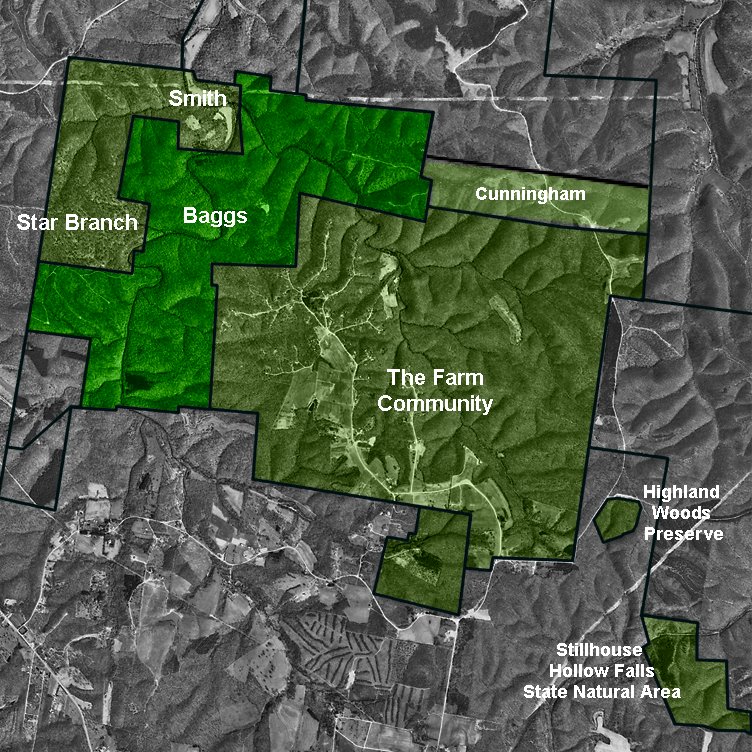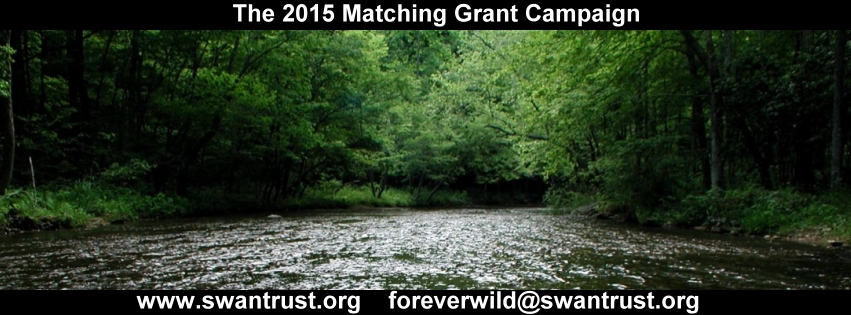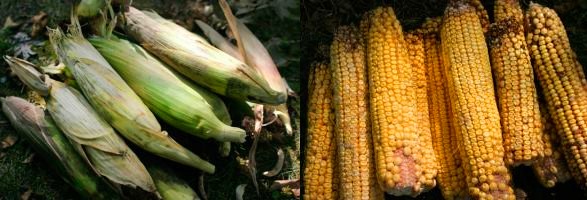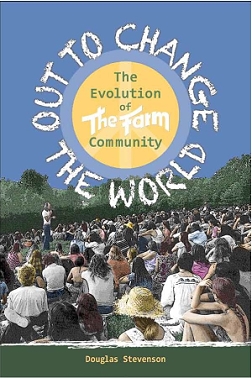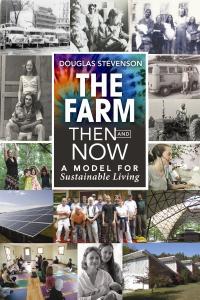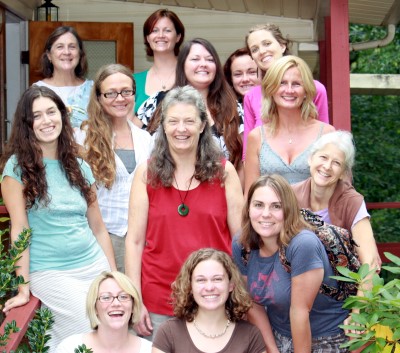The Full Story
When we moved to Middle Tennessee to found The Farm Community in the early 1970's, the area consisted primarily of small farms, with vast tracts of undeveloped forest. Sawmills were mostly family operations, many run by the Amish.
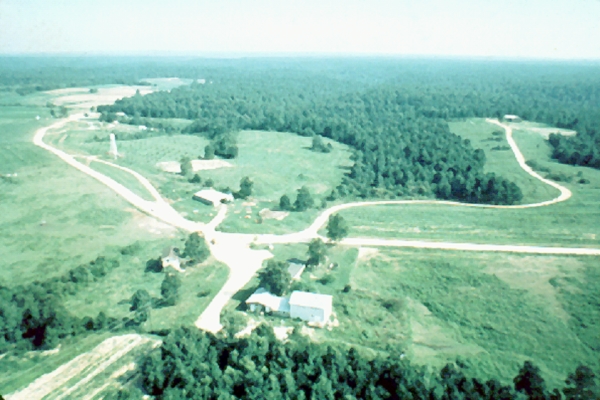
The Farm in the early 1970sIn the early 80's that began to change, as multinational timber companies began to flee the northwest, where tighter environmental regulations, symbolized by the spotted owl, made business as usual more difficult. In contrast, land in the south could still be had for a couple hundred dollars an acre, and there were virtually no government restrictions to contend with.
Around 1981 or 82, an 1100 acre property that bordered The Farm, owned by the Baggs family, was offered to us for sale, a beautiful forest with two huge creeks. Unfortunately, the deal came at a time when the community was beginning to sink financially, and there was no way we could even consider such a purchase. Consequently it was acquired by a large timber company based in Portland, Oregon, named Willamette.
By the mid-90's, the community had eliminated all of its debts, and we were getting back on our feet. We were given first option on another 650 acre property, one with special significance to us. It was the place next door where the original school bus caravan had landed on the historical trip from California to Tennessee.
A number of us formed a committee to figure out a way to purchase the land. Our plan was to form a corporation to buy the land and then immediately subdivide it and sell pieces back to ourselves and our many friends and former members, now spread out across the country. We called it "Highland Woods."
After about six months of planning, a list of people willing to purchase pieces of 2, 5, 15, 35 acres or more had been developed. In the meantime, inspired by the idea of harnessing the energy of our greater network to save more land around us, a smaller group began meeting to explore a new form of nonprofit - the land trust.
Swan Conservation Trust was established with a 10 acre donation from Highland Woods, a remote section with no road access, which meant it would not be practical for anyone to later build a house there. There was agreement it would better serve the members of Highland Woods to keep this as undeveloped land. About a year later, Swan Trust agreed to purchase an additional 90 acres of Highland Woods. The idea was that with a land base, Swan Trust would have the credibility it would need to seek grants and begin negotiations on our real goal, the purchase of the 1100 acres Baggs tract.
The local representative at Willamette agreed to meet with us, but they had no interest in selling any land. Once a year the hardcore timber harvesters would spend about an hour face to face with the tree huggers and tease each other in a friendly way. This went on for 10 years.
In the meantime Swan Trust began buying more land. We started with 5 acres, then bought an additional 50 acres from a neighbor, land adjacent to both The Farm and The Baggs land, which contained the confluence of Cox Branch (which originates on The Farm) and Big Swan Creek. It was an incredible score.
In 1998 Swan Trust made the bold move of outbidding a developer at a land auction to purchase another 300 acres adjacent to the Baggs tract for around $325 an acre. The property had been recently clear cut, but included a steep valley that still had standing timber, and a small tributary of Big Swan Creek called Star Branch. Even more important, our ownership cut off a possible road access, making it more difficult for Willamette to reach the 800 acres of standing timber that remained on the Baggs land.
In 2004 we received a call from our man at Willamette. Rumors were flying through the corporate offices of a possible merger or takeover. If we were going to do this deal, the time was now.
A contract was drawn up to purchase the 1100 acres for $400 an acre, $440,000, a bargain sale due to Willamette receiving a huge tax write off based on a donation of the timber (valued at an additional $400,000) to Swan Trust. The contract was sent to the corporate offices in Oregon to be signed.
And then the news. Willamette had succumbed to a hostile takeover by the corporate timber giant, Weyerhaeuser.
We were back to square one. Fortunately our local contact still held his same position, and he set up a meeting for us with the new higher ups at Weyerhaeuser to negotiate a new deal. They agreed to meet with us, and a new contract was drawn up, this time for 750 acres but at nearly double the cost of the original contract. Unfortunately we hit another set back when Weyerhaeuser decided not to sell to us. Instead, they put their entire holdings in Tennessee up for sale, 14,000 acres. Within a few weeks the entire lot was purchased by a timber/investment company out of Florida, Fountain Investments.
The good news was that the owner of Fountain Investments understood the value of conservation. MC Davis was considered the largest private owner of conservation land in the country, next to Ted Turner. He agreed to have a representative meet with us.
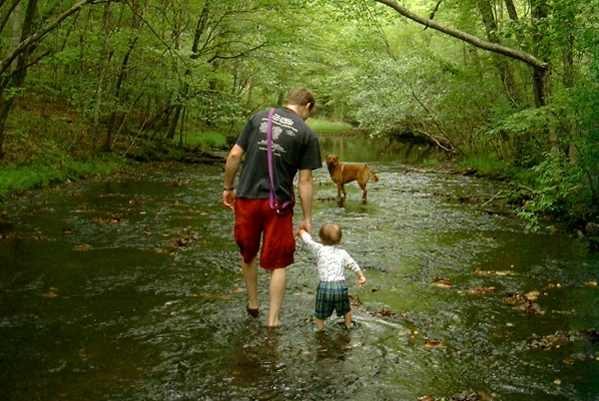
I dedicate my work with Swan Trust to the memory of my grandson Julian,
and to all children of future generations.
I think they were a bit amused by myself and my pony-tailed hippie brother Mike, and our passion to acquire this piece of land. We negotiated for several months before signing a contract. This was followed by a closing at the bank, when in December of 2004 I signed the note that set our payments at over $5000 a month. Slightly more than half of each payment went to interest. As we rode home, the main thing on my mind was, “What have I done?”
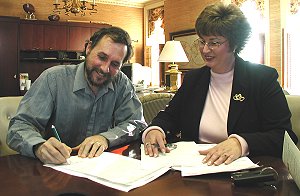
Signing the note.In a way, the first few years were the easiest. Our core group of supporters were enthusiastic and came through with donations ranging from $25 to $1000. In order to raise some large amounts of capital, we sold two sections along the outer boundary to conservation buyers who shared our vision of preserving the land. In the meantime we also purchased two additional properties that were critical to the integrity of the Preserve.
We had our share of good luck over the years. We received $25,000 from a Tennessee environmental fund, and another $25,000 from some former members of The Farm Community from the sale of a farm in New York.
Then the economy hit 2008 and the global depression. Donations plummeted.
Fortunately, at about the same time, a $60,000 State grant for the preservation of wetlands came through, which enabled us to stay current with our payments. We sold an additional 80 acres, bringing the total amount of land in the Preserve to 1425 acres. The land sale got our debt down to under $200,000, which allowed us to refinance and our interest rates in half, lowering our monthly payment to under $1800, spread out over ten more years.
With closing costs, surveys, not to mention the amount we have had to pay in interest, the total we have raised so far is about $1.2 million.
I can tell you, it all seemed pretty daunting at the beginning. But I had to recognize that it was better try and fail than not to try at all.
In 2014 an angel came to Swan Trust's aid in the form of a $50,000 gift, bringing the amount left on the note down to $70,000.
The fulfillment of this project has taught me a lot, especially about what can be accomplished when people work together, each contributing in their own way. For example, my talents lie in communication, so I do things like the web site, newsletters and mailings, and organize fundraising events. Cynthia is a biologist with good connections to corresponding people in State government and in the land trust movement. Chris does our books and keeps us organized. Each person on our board brings something unique to the table, and it is the whole of us together that has allowed this project to succeed.
But all of you that deserve equal credit. Clearly it is because of your support and belief in this work that had made Big Swan Headwaters Preserve a reality.
So now here we are on the home stretch with a big push to see this project through top the end. I hope you will be able to join us for a note burning party December 31 and celebrate Big Swan Headwaters Preserve…
as land free and clear.




